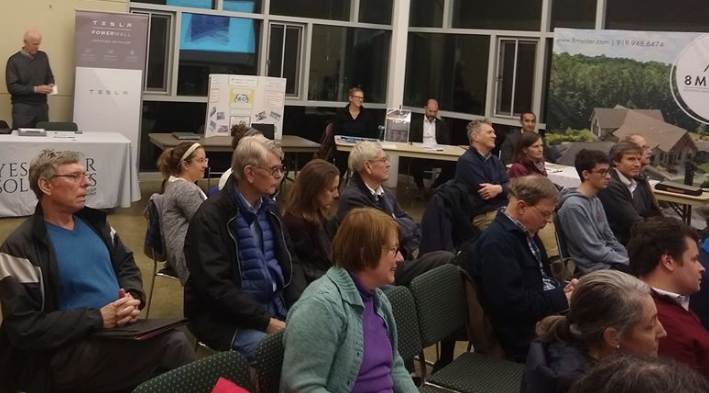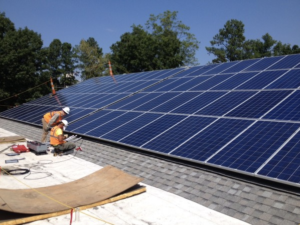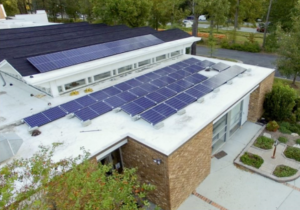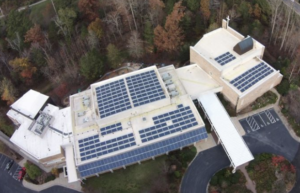In conversations about solar collectors, you don’t expect to hear the phrase “Manna from Heaven”—yet that was exactly the topic of a meeting of Orange Chatham Interfaith Creation Care (OCICC) in January 2020.

This organization of faith leaders from many houses of worship came together to encourage the care of the Earth; their January meeting discussed the transition to solar power for houses of worship, with testimonial from congregations who have made the change. The meeting of about 80 participants was hosted at the United Church of Christ in Chapel Hill by John Wilson, a member of OCICC’s steering committee and member of Chapel Hill’s University Presbyterian Church.
The world has changed since that evening in January. Transforming a World in Triple Crisis, a more recent gathering, was online and sponsored jointly by OCICC and Interfaith Creation Care of the Triangle. As discussed that evening, the pandemic has made the need for environmental and economic change abundantly clear. And solar energy is a way for faith communities to continue to lead on caring for the world around us, even while we stay physically apart.

At the January meeting, multiple speakers talked about an amazing thing that happened: even though they emphasized the economics of going solar—the manna— their congregations came to recognize that the cost benefits of solar conversion were secondary to the faith-inspired work of saving our planet. Several churches went out of their way to make the solar panels visible to the congregations, even though most roofs were flat and not visible from the ground.
Kathy Kaufman of the Kehillah Synagogue led off the evening with a dire fact about climate change: science has proven that a one-degree Celsius increase in the temperature of the oceans produces a 23% increase in the intensity of storms. That hit home for many North Carolinians, who have experienced more than one “500-year” flood in the last few years.
Kaufman pointed out that North Carolina gets 30% of its energy from Natural Gas, 27% from Coal, and 33% from Nuclear. Although some statistics claim a 10% return on investment for a natural gas-powered plant but only 8% for a solar powered utility, these figures do not account for the costs of societal and environmental damage. Fossil-fuel-based utilities remain profitable for now, but newspapers report that Duke Energy will have to spend upwards of $9 billion dollars to close the basins used to safeguard over 80 million tons of coal ash. Duke will likely pass this cost on to the electric users.
North Carolina law related to solar power is in flux. Many grants and programs available to individual homeowners are not available to churches and other nonprofit organizations. However, early adopter institutions said that the application process has become much more straightforward than it was just a few years ago.
The stories of solar transformations in institutions of prayer tended to start with budgetary concerns. Many started small by changing out regular bulbs for LED bulbs, although United Church of Christ Chapel Hill started with a plan that required them to raise thousands of dollars up front. Orange Chatham Interface Council started with controlling lightbulb and air conditioning costs; that alone saved them a large portion of their utility bills.

Binkley Earth Ministries started their Earth stewardship with a goal of raising $20,000 but raised $40,000, which they used to buy 50 silicon solar panels.
Up-front project costs were a major concern. The Community Church of Chapel Hill formed a limited partnership or LLC to help raise $25,000. Although this approach involved start-up costs, it let the church take advantage of state and federal government rebates not normally available to churches. The church purchased 100 panels and received an $80 rebate for each. The young people of the congregation actively raised money for the project, and it became the sacred duty of young and old to work together on this mission.
Some congregations are considering leasing solar panels instead of buying them. Such arrangements eliminate the costs of ownership but give away some of the benefits to the leasing company. Saint Francis of Assisi Roman Catholic church is about to take this approach on their sprawling Leesville Road campus in Raleigh.
The speakers addressed questions on many topics: insurance, panel warrantees, the steady decrease in the price of electrical components, panel optimizers, lost efficiency during the summer heat, and even system obsolescence.
Before the meeting, various companies and programs addressed technical questions at informational tables at the back of the meeting room. Southern Energy Management, of Raleigh, assists developers, architects, and general contractors in navigating the maze of building performance programs. They have 15,000 installations under their belt. They are a Certified B Corporation, which means that they are evaluated to meet rigorous standards of social and environmental performance.

Solar Solutions claims to be the only PV Installation Company on the East Coast accredited by the North American Board of Certified Energy Practitioners.
Eagle Solar and Light claims to be the only solar leasing company established in North Carolina after House Bill 589 was signed into law in 2017. They say that Duke Energy will rebate tax-exempt entities up to $75,000, depending on system size.
The NC Solar Rebate Program, run by Duke Energy, reserves 2.5 Megawatts of annual capacity to nonprofit organizations, out of a total 10MW dedicated to the program.
The local branch of Interfaith Power and Light, a national organization of more than 18,000 faith communities, also participated in the meeting. They circulated a powerful statement on aims and responsibilities of the movement, which can be found at the end of this blog post.
The evening ended with participants speaking on a variety of topics: a possible climate strike, a new program to engage congregations by installing power charging stations for cars, power walls of batteries, and bringing more congregations of color into the discussion.
To learn more about what solar “Manna from Heaven” can do for your faith community, please visit NC Interfaith Power & Light’s Energy Efficiency & Renewable Energy Programs.
Interfaith Power and Light Statement:
The climate change crisis most impacts those who contribute the least to the problem: the poor and vulnerable. That’s why over 18,000 faith communities are working with Interfaith Power and Light to green their facilities, teach and preach about global warming as a moral issue and mobilize for policy change. The United States, a wealthy nation with vast resources, has a unique responsibility to show moral and political leadership by:
- Transitioning from dependence on fossil fuels toward a clean energy economy.
- Honoring the emissions-reduction commitments our nation made at the UN Conference on Climate Change in Paris in 2015, and taking additional actions needed to avert catastrophic global warning.
- Assisting developing nations—who are least responsible for climate change but most impacted by it—in coping with threats such as increased droughts, floods and sea-level rise by sharing clean energy technology and other supports.




